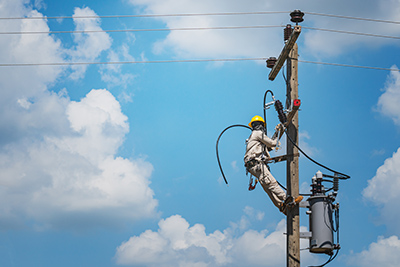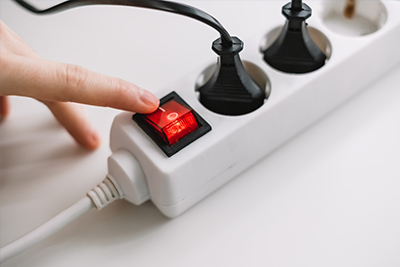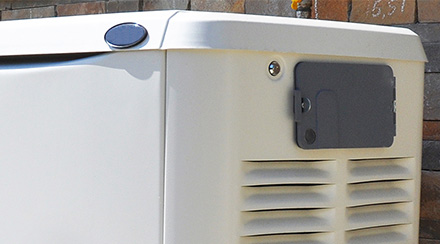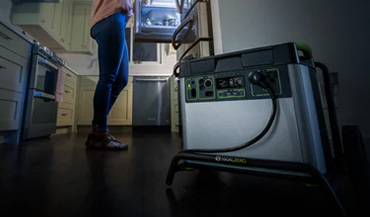What Is a Power Surge – and What’s Surge Protection?
It’s always frustrating when a device or appliance suddenly stops working, especially when it’s unclear what the problem is. Sometimes, mysterious breakdowns like this can be the result of power surge damage – a common threat that can degrade your devices over time or simply fry them in an instant.
What Are Power Surges?
When the voltage or electrical current flowing through an electrical system exceeds that system’s maximum capacity, it’s called a power surge. If a power surge flows all the way through an electrical system to a sensitive device, such as a smartphone, computer or television, the surge can damage the device, potentially beyond repair.
What Causes Power Surges?

Power surges can originate from a variety of sources. Some of these sources are dramatic, like when lightning strikes or an electrical transformer blows. But other sources are unnoticeable, like when your refrigerator’s compressor cycles on and off. Powerful appliances can cause smaller power surges as part of their normal operation, and these surges can flow to other appliances and electronics that are connected to the same circuit.
Other events that can cause power surges are when the electricity goes out or comes back on (either unexpectedly or intentionally), when an appliance trips a circuit breaker or when there’s a short circuit somewhere in an electrical system.
How Can an Electrical Surge Damage Electronics and Appliances?
When a power surge reaches one of your devices or appliances, some amount of damage is possible. If it’s a small power surge created by one of your major appliances cycling on or off, the damage might not cause any noticeable differences in the affected devices, but may shorten the life span of some electrical components. Repeated exposure to power surges of this type can slowly destroy a device over time.
Larger power surges can cause electricity to arc within a device or appliance, which can be instantly destructive. Arcing electricity can scorch sensitive components like circuit boards, transistors, resistors and sensors, and can even start a fire in extreme cases.
Power surge damage is difficult for an electrical layperson to self-assess. If you have a device that suddenly stops working after a noticeable event like a nearby lightning strike or sudden power outage, it’s probable that those events are connected. But if a device stops working prematurely with no apparent cause, you’ll need a qualified repair technician to tell you whether power surge damage is the cause.
What’s Surge Protection?

What Does a Surge Protector Do?
If you use one of these surge protectors to connect your sensitive electronics to your home electrical system, excessive current will be “arrested” by the surge protector – which means it gets bypassed directly to your home’s ground wire, which allows the current to flow harmlessly into the ground.
How Does a Surge Protector Work?
You should think of your surge protector as sacrificing itself for your other electronics and appliances, because power surges eat away at a surge protector’s life span. Every surge protector has a “joule rating,” which indicates how many joules of electricity it can absorb before it becomes ineffective. Once a surge protector’s capacity has been exhausted, it will still function as a power strip, but it won’t provide any protection.
To make sure your devices are always protected, there are a few things to look out for when buying and using surge protectors. First, choose a surge protector with a joule rating of at least 1000 joules. These higher-capacity surge protectors will last longer and provide better protection against larger power surges. Second, choose a model with an indicator light that shows whether the surge protector is fully operational. Surge protectors don’t tell you how many joules of protection they have left, but many models have this light to show whether they’re still working. Finally, check the indicator light regularly, especially after lightning storms and power outages, and replace your surge protector as needed.
There are more heavy duty forms of surge protection, too. Whole home surge protection can be installed in your main electrical panel by a licensed electrician, and can protect some or all of the circuits in your home. This provides a strong baseline of surge protection, which can be enhanced by using surge protection power strips with your most sensitive or valuable electronics.
You may also be protected by a service entrance surge protector if you live in an apartment building or other multi-unit residence. These surge protectors are installed even further upstream, between a dwelling’s main electrical panel and the electric utility’s transformer, offering even greater protection capacity than whole home surge protection. Some newer homes may have this feature, but service entrance surge protection is uncommon among single-family homes.
Is There Another Way to Protect Against Power Surges?
One of the most vexing aspects of power surges is that they can occur and cause damage without our knowledge. Unless you’re using surge protection in your home, there could be small surges coursing through your circuits right now, silently and invisibly harming your devices and appliances. But one of the greatest power surge threats – lightning – makes its presence known with flashes of light and booming thunderclaps.
When a lightning storm is passing close to your home, the one sure-fire way to protect your devices is to unplug them. It’s not practical to do this with everything – your refrigerator needs to keep running, of course – but it’s never a bad idea to unplug your smartphone, computers and entertainment electronics if you can see lightning near your house. If you’re already using surge protection power strips with these electronics, you can do this easily by unplugging the power strip – which can help your surge protector last longer, too!
Looking for Something Specific?
Select a category to find resources for topics that interest you.
Select Category

Related Articles:

What to Do Before, During and After Power Outages
With a little knowledge and preparation, you can protect yourself, your home and your belongings during power outages of any duration.
Read Article
How to Choose a Generator for Your Home
Power outages can be miserable, but with the right generator, you can keep your family safe and comfortable until power is restored. Learn how to choose the best generator for your home.
Read Article
Weatherize Your Home for Summer
The extreme heat of summer can really do a number on your energy bills. But if you’re able to invest a little time and money into weatherizing to keep your home cool, you can help yourself and your family remain comfortable at home while still saving energy.
Read ArticleMost Popular Articles

Power On the Go
GoalZero's portable and whole-home power products help you get the energy you need, whenever and wherever you need it. Learn More.
What Is a Power Surge – and What’s Surge Protection?
It’s always frustrating when a device or appliance suddenly stops working, especially when it’s unclear what the problem is. Sometimes, mysterious breakdowns like this can be the result of power surge damage – a common threat that can degrade your devices over time or simply fry them in an instant.
What Are Power Surges?
When the voltage or electrical current flowing through an electrical system exceeds that system’s maximum capacity, it’s called a power surge. If a power surge flows all the way through an electrical system to a sensitive device, such as a smartphone, computer or television, the surge can damage the device, potentially beyond repair.
What Causes Power Surges?
Power surges can originate from a variety of sources. Some of these sources are dramatic, like when lightning strikes or an electrical transformer blows. But other sources are unnoticeable, like when your refrigerator’s compressor cycles on and off. Powerful appliances can cause smaller power surges as part of their normal operation, and these surges can flow to other appliances and electronics that are connected to the same circuit.
Other events that can cause power surges are when the electricity goes out or comes back on (either unexpectedly or intentionally), when an appliance trips a circuit breaker or when there’s a short circuit somewhere in an electrical system.
How Can an Electrical Surge Damage Electronics and Appliances?
When a power surge reaches one of your devices or appliances, some amount of damage is possible. If it’s a small power surge created by one of your major appliances cycling on or off, the damage might not cause any noticeable differences in the affected devices, but may shorten the life span of some electrical components. Repeated exposure to power surges of this type can slowly destroy a device over time.
Larger power surges can cause electricity to arc within a device or appliance, which can be instantly destructive. Arcing electricity can scorch sensitive components like circuit boards, transistors, resistors and sensors, and can even start a fire in extreme cases.
Power surge damage is difficult for an electrical layperson to self-assess. If you have a device that suddenly stops working after a noticeable event like a nearby lightning strike or sudden power outage, it’s probable that those events are connected. But if a device stops working prematurely with no apparent cause, you’ll need a qualified repair technician to tell you whether power surge damage is the cause.
What’s Surge Protection?
What Does a Surge Protector Do?
If you use one of these surge protectors to connect your sensitive electronics to your home electrical system, excessive current will be “arrested” by the surge protector – which means it gets bypassed directly to your home’s ground wire, which allows the current to flow harmlessly into the ground.
How Does a Surge Protector Work?
You should think of your surge protector as sacrificing itself for your other electronics and appliances, because power surges eat away at a surge protector’s life span. Every surge protector has a “joule rating,” which indicates how many joules of electricity it can absorb before it becomes ineffective. Once a surge protector’s capacity has been exhausted, it will still function as a power strip, but it won’t provide any protection.
To make sure your devices are always protected, there are a few things to look out for when buying and using surge protectors. First, choose a surge protector with a joule rating of at least 1000 joules. These higher-capacity surge protectors will last longer and provide better protection against larger power surges. Second, choose a model with an indicator light that shows whether the surge protector is fully operational. Surge protectors don’t tell you how many joules of protection they have left, but many models have this light to show whether they’re still working. Finally, check the indicator light regularly, especially after lightning storms and power outages, and replace your surge protector as needed.
There are more heavy duty forms of surge protection, too. Whole home surge protection can be installed in your main electrical panel by a licensed electrician, and can protect some or all of the circuits in your home. This provides a strong baseline of surge protection, which can be enhanced by using surge protection power strips with your most sensitive or valuable electronics.
You may also be protected by a service entrance surge protector if you live in an apartment building or other multi-unit residence. These surge protectors are installed even further upstream, between a dwelling’s main electrical panel and the electric utility’s transformer, offering even greater protection capacity than whole home surge protection. Some newer homes may have this feature, but service entrance surge protection is uncommon among single-family homes.
Is There Another Way to Protect Against Power Surges?
One of the most vexing aspects of power surges is that they can occur and cause damage without our knowledge. Unless you’re using surge protection in your home, there could be small surges coursing through your circuits right now, silently and invisibly harming your devices and appliances. But one of the greatest power surge threats – lightning – makes its presence known with flashes of light and booming thunderclaps.
When a lightning storm is passing close to your home, the one sure-fire way to protect your devices is to unplug them. It’s not practical to do this with everything – your refrigerator needs to keep running, of course – but it’s never a bad idea to unplug your smartphone, computers and entertainment electronics if you can see lightning near your house. If you’re already using surge protection power strips with these electronics, you can do this easily by unplugging the power strip – which can help your surge protector last longer, too!
Looking for Something Specific?
Select a category to find resources for topics that interest you.
Select Category

Related Articles:

What to Do Before, During and After Power Outages
With a little knowledge and preparation, you can protect yourself, your home and your belongings during power outages of any duration.
Read Article
How to Choose a Generator for Your Home
Power outages can be miserable, but with the right generator, you can keep your family safe and comfortable until power is restored. Learn how to choose the best generator for your home.
Read Article
Weatherize Your Home for Summer
The extreme heat of summer can really do a number on your energy bills. But if you’re able to invest a little time and money into weatherizing to keep your home cool, you can help yourself and your family remain comfortable at home while still saving energy.
Read ArticleMost Popular Articles

Power On the Go
GoalZero's portable and whole-home power products help you get the energy you need, whenever and wherever you need it. Learn More.







